NDC FAQ
General FAQ
1. General / The RAC sector and its relevance
What is the RAC sector?

The refrigeration and air-conditioning (RAC) sector includes refrigeration and air conditioning appliances and systems. Even if we are often not consciously aware of it, we encounter the RAC sector in many parts of our lives. The cooling of buildings, the proper storage of food and medicine or the transport of vaccines over long distances are just a few examples. More examples and explanations of the subsectors can be found on the GCI website on cooling subsectors (opens in a new window).
Why is the RAC sector important?

Refrigeration and air conditioning (RAC) is vital for human well-being, for example, to prevent food loss and guarantee supply with medical care with functioning cold chains and alleviate heat stress through space cooling. Yet, the use of cooling technologies can also have downsides. The sector emits massive amounts of greenhouse gases. Cooling produces more than 7% of the world’s greenhouse gas emissions, expected to roughly double by 2050 (Clean Cooling Collaboration (opens in a new window), 2017). These result from the energy consumption of appliances, aggravated by the large amount of inefficient equipment still on the market. Refrigerant emissions from commonly used synthetic refrigerants account for about one third of total cooling emissions. The Global Warming Potential (GWP) of many of the refrigerants contained in air conditioners, refrigerators and insulating foams is around 2000. The greater the GWP of a refrigerant, the greater its ability to cause global warming. As a point of orientation, this means that 2.4 kg of a refrigerant with a GWP of 2000 is equivalent to about 5 tons of CO2.
In addition to these direct emissions caused by the leakage of fluorinated greenhouse gases, so-called F-gases, into the atmosphere, the operation of commercial equipment consumes an enormous amount of energy. This energy consumption results in high indirect emissions during electricity generation. Many appliances are also still operated with ozone depleting substances (ODS), such as chlorofluorocarbons (CFCs) and hydrochlorofluorocarbons (HCFCs), which additionally to their ozone-depleting characteristic also have a very high GWP.
Which refrigerants exist and how can they be clustered concerning their environmental impact?
Gases, that are used as refrigerants can be clustered into synthetic and natural refrigerants.
Synthetic refrigerants such as chlorofluorocarbons (CFCs), hydrochlorofluorocarbons (HCFCs) and hydrofluorocarbons (HFCs) are mostly used in conventional cooling appliances. They are produced synthetically and are considered to be harmful to the environment because their Ozone Depletion Potential (ODP) and/or Global Warming Potential (GWP) are very high (many of them have a GWP over 2000 which means that 2.4 kg of the refrigerant is equivalent to about 5 tons of CO2). In addition, their atmospheric breakdown products contribute to the accumulation of harmful persistent chemicals in the aquatic biosphere.
Natural refrigerants, in contrast, are part of natural biogeochemical cycles and do not form persistent wastes in the atmosphere, water, or biosphere. Therefore, they have no or minimal GWP and zero ODP. Additionally, they are less expensive than synthetically produced F-gases and have no patent rights. However, there are still some barriers to overcome in moving towards using naturaly refrigerants in the RAC Sector. These barriers include financing options (e.g. when converting production lines for cooling appliances), standards and regulations, as well as adequate training of technicians in the safe handling of natural refrigerants.
The "Natural 5" are CO2, ammonia, water, air and hydrocarbons, such as propane, isobutane and propene/propylene. More information can be found here (opens in a new window).
What is the “Green Cooling” approach?

The Green Cooling approach aims for a global shift towards a more sustainable cooling sector. Emissions caused by energy-inefficient appliances (indirect emissions) and the use of refrigerants with a high Ozone Depleting Potential (ODP) and/or Global Warming Potential (GWP) (direct emissions), are targeted to be reduced. Recommended measures are building insulation to reduce cooling load, the replacement of old equipment with climate-friendly and energy-efficient solutions and the use of natural refrigerants. In ideal case, the cooling appliances are powered by renewable energies. Green Cooling is an important contribution to GHG- and ODS-mitigation and thus to climate protection. It also includes globally promoting to make the leap from using HCFCs to natural refrigerants, rather than switching to HFCs as a transitional solution, which are still climate-damaging.
More information on the Green Cooling approach can be found here (opens in a new window).
Which measures can be taken to shift to a sustainable cooling sector?
Substitute synthetical refrigerants by natural refrigerants
Use energy-efficient cooling appliances, electrified by renewable energy
Reduce cooling load through adequately insulated building structures
Improve HFC and HCFC banks management to reduce leakage
A holistic approach consisting of policy advice, technology transfer with the private sector, and capacity building, especially through targeted training of refrigeration technicians, is needed to successfully implement these measures.
Specific FAQ
2. Integration of the refrigerant and air conditioning (RAC) sector in Nationally Determined Contributions (NDCs)
Why should the RAC sector be included in NDCs?
The RAC sector is responsible for more than 7% of global GHG emissions. Reducing those emissions is therefore important to reach the objectives of the Paris Agreement goals. Technical solutions exist for almost all RAC subsectors. They are very cost-efficient and therefore considered as “low hanging fruits”. The RAC sector’s inclusion in the Nationally Determined Contributions (NDCs) is an important step to politically manifest specific mitigation targets and measures. The NDCs build the core of the Paris Agreement and represent each country's efforts to reduce national emissions, adapt to the consequences of climate change, and therefore the implementation of the long-term goals of the Paris Agreement. Only through a holistic climate policy approach, GHG emissions can be successfully mitigated and decoupled from a growing cooling demand. Integrating the sector in NDCs also increases possibilities of international climate finance. For more information, please check the NDC Guideline for policymakers. (opens in a new window)
What kind of measures in the RAC sector could be included in a NDC?
There are several options for including RAC related measures in a NDC depending on national conditions. Generally, refrigerant related emissions and energy related emissions, cooling load as well as ODS and HFC banks management and destruction can be addressed.
The following presents an overview of possible measures:
Measures targeting refrigerant related emissions
- Financial instruments to reduce HFC consumption
- Overall (economy-wide) declared HFC consumption reduction targets
- Regulatory instruments to reduce HFC production and consumption
- Regulatory instruments to promote containment and re-use of HFC refrigerants
- Market-related instruments to reduce HFC consumption
- Capacity building for technicians
- Regulatory instruments to manage end-of-life treatment of refrigerants and appliances
- Tracking and MRV of HFC consumption and emission
Measures targeting energy related emissions
- Enforcement of energy efficiency regulations
- Regulatory instruments to promote higher energy efficiency of equipment
- Financial instruments to support higher energy efficiency in equipment
More details on the listed measures can be found in the NDC RAC Guideline (opens in a new window). To analyse the ambition of current and planned RAC-related NDC measures, please make use of the quick self-analysis to evaluate cooling sector-related targets and measures included in NDCs (opens in a new window) or the excel-based benchmarking tool (opens in a new window). In case of any further or more specific questions, contact the NDC4 Help Desk Team (opens in a new window).
In which NDC chapter can cooling/the RAC-sector be incorporated?
Depending on the mitigation focus, the sector can be included in the energy- (energy related emissions) or the Industrial Processes and Product Use (IPPU) (refrigerant related emissions) sector. Alternatively, the RAC sector can be assigned its own sector to cover both types of emissions.
How can I measure the ambition level of the cooling-related measures I plan to implement in an NDC?
To get a first overview of the ambition level of current and planned RAC-related NDC measures, please make use of the excel-based benchmarking tool (opens in a new window). The tool serves as an indication for decision-makers whether policy targets are appropriate.
I want to integrate the RAC sector in a NDC. Where do I begin / How do I proceed?
The NDC RAC Guideline (opens in a new window) suggests five strategic components for integrating the RAC sector in a NDC:
- Establish a solid data base in the form of a detailed RAC sector GHG inventory
- Come up with a comprehensive cooling sector mitigation approach including long-term strategies and implementation plans that build on the HFC reduction obligations mandated by the Kigali Amendment while addressing emissions from energy use
- Anchor the cooling sector in the NDC update process based on specific NDC components developed by cooling sector representatives
- Link the cooling sector with other relevant cross sectors (building-, energy-efficiency sector) and their targets and coordinate with the respective (governmental) actors
- Develop a tracking and Monitoring, Reporting and Verification (MRV) system for HFC emissions that is in line with the Montreal Protocol and the Paris Agreement
Further information on certain steps are provided in the referred Guideline (opens in a new window).
Where can I find country examples for the RAC sectors’ implementation in a NDC?
More than half the countries that developed an updated NDC have recognized the relevance of the cooling sector, and specifically the importance of HFC emissions. However, there is still a huge gap in terms of concrete actions and implementation strategies. Detailed action plans that underpin quantitative mitigation targets in the cooling sector are rarely found in the current versions of updated NDCs. This is also why GIZ Proklima developed the NDC Guideline (opens in a new window).
Examples of countries that GIZ Proklima has advised on this matter can be found on the GCI Website (opens in a new window). Here (opens in a new window), you can watch a recording in which Namibia’s National Ozone Unit (NOU) shares the country’s experiences about including the RAC sector in the updated NDCs in 2021. Here (opens in a new window) you can read how Kenia, Ghana, and the Seychelles are advancing the sector on their political agenda. In the NDC Guideline (opens in a new window), various best practice example from different countries are published, for example Australia’s Regulation Impact Statement evaluating the reduction HFC emissions or the United States’ Significant New Alternatives Policy (SNAP) Programme, evaluating substitutes for ozone-depleting substances.
Which documents can help me to find a starting point for my country’s process?
An overview of publications with a short description can be found here (opens in a new window).



